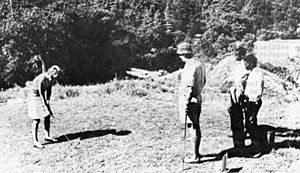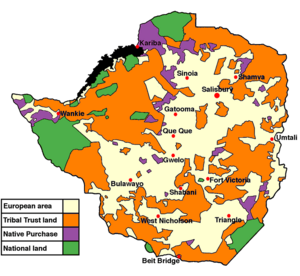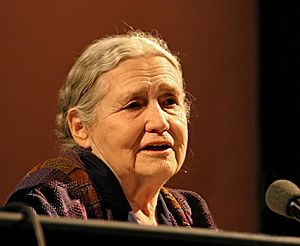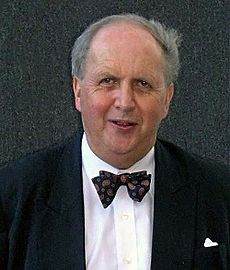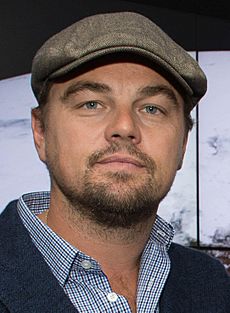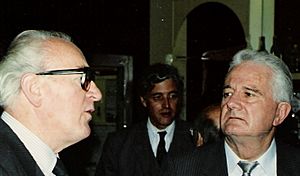White Zimbabweans facts for kids
| Rhodesians | |
|---|---|
 
Historical flags of the Republic of Rhodesia and Southern Rhodesia
|
|
| Regions with significant populations | |
| 200,000 (2006) | |
| 64,261 (2002) | |
| 10,591 (2006) | |
| Languages | |
| English (majority), Afrikaans, Greek, Portuguese, Italian, others (minority), Zimbabwean English | |
| Religion | |
| Predominantly Christianity, Judaism | |
| Related ethnic groups | |
| White South Africans, White Namibians, Afrikaners, Coloureds, other White Africans, Jews in Africa | |
| Historical population | ||
|---|---|---|
| Year | Pop. | ±% |
| 1891 | 1,500 | — |
| 1895 | 5,000 | +233.3% |
| 1900 | 12,000 | +140.0% |
| 1904 | 12,596 | +5.0% |
| 1911 | 23,606 | +87.4% |
| 1914 | 28,000 | +18.6% |
| 1920 | 32,620 | +16.5% |
| 1924 | 39,174 | +20.1% |
| 1930 | 47,910 | +22.3% |
| 1935 | 55,419 | +15.7% |
| 1940 | 65,000 | +17.3% |
| 1945 | 82,000 | +26.2% |
| 1950 | 125,000 | +52.4% |
| 1953 | 157,000 | +25.6% |
| 1960 | 218,000 | +38.9% |
| 1965 | 208,000 | −4.6% |
| 1970 | 237,000 | +13.9% |
| 1975 | 300,000 | +26.6% |
| 1979 | 242,000 | −19.3% |
| 1985 | 100,000 | −58.7% |
| 1990 | 80,000 | −20.0% |
| 1995 | 70,000 | −12.5% |
| 2002 | 46,743 | −33.2% |
| 2012 | 28,732 | −38.5% |
White Zimbabweans are people in Zimbabwe who have European family backgrounds. Most of them speak English and are descendants of British settlers. A smaller number speak Afrikaans, a language from South Africa, or have Greek, Portuguese, or Italian roots.
A small group of British people first came to the British colony of Southern Rhodesia (which later became Zimbabwe) in the late 1800s. More European people continued to move there for the next 75 years. The white population in Southern Rhodesia (or Rhodesia after 1965) grew to about 300,000 by 1975–76. This was about 8% of the total population. After Zimbabwe became independent in 1980, many white people left. Their numbers dropped to about 220,000 in 1980, 70,000 in 2000, and 30,000 in 2012.
Contents
Early History of White Settlers
Present-day Zimbabwe was known as Southern Rhodesia from 1895. The British South Africa Company (BSAC) took control of the area in the 1890s. Early white settlers came looking for valuable minerals like gold.
Zimbabwe is on a high plateau, which means it has a mild climate. This climate was good for European settlement and for farming. White settlers who helped the BSAC take over the country were given large areas of land. Black people already living on this land became tenants, meaning they had to pay to live there.
In 1930, new laws called the Land Apportionment and Tenure Acts moved African people from the best farmland. This land was then set aside for white ownership. White settlers were drawn to Rhodesia because they could buy good farmland cheaply from the government. This led to a lot of commercial farming in the colony.
White farms were usually very large, often over 100 square kilometers. They were owned by white families and employed hundreds of black workers. Many of these farms provided homes, schools, and clinics for their black employees and their families. By 1980, when Zimbabwe became independent, about 5,000 white farms made up over 40% of the country's farmed land.
At that time, farming contributed 40% of Zimbabwe's total economic output and up to 60% of its foreign earnings. Key export products included tobacco, beef, sugar, cotton, and corn. Mining was also important, with gold, asbestos, nickel, and chromium being mined by large companies.
A survey in 1921 showed that Southern Rhodesia had about 899,187 people. This included 33,620 Europeans, 1,998 mixed-race people, 1,250 Asians, and over 860,000 African people. In 1922, Southern Rhodesians voted against joining South Africa. Instead, the country became a self-governing British colony.
Immigration and Growth
In 1891, before Southern Rhodesia was officially a territory, about 1,500 Europeans lived there. This number slowly grew to around 75,000 by 1945. Between 1945 and 1955, the white population doubled to 150,000. During this time, 100,000 black people were forced to move from land that was set aside for white ownership.
Many white people moved to Rhodesia after the Second World War. By 1962, Rhodesia had 221,000 white residents. At its highest point in the mid-1970s, the white population reached about 277,000. Many new immigrants were former British soldiers or refugees from communism in Europe. Others came from former British colonies like Kenya, or from Zambia, Algeria, and Mozambique. For a while, Rhodesia was seen as a safe place for white people leaving other parts of Africa and Asia.
After World War II, new white settlers in Rhodesia were seen as different from earlier settlers or those in other British colonies. They were often from working-class backgrounds, unlike the wealthier settlers in places like Kenya.
Several things helped the white population grow in Rhodesia. These included the country's growing economy and prosperity after the war. The formation of the Central African Federation (1953-1963) also encouraged British settlement and investment. This Federation, which included Southern Rhodesia, Northern Rhodesia (now Zambia), and Nyasaland (now Malawi), created a strong economic area. Many new immigrants believed that white rule would last longer in Rhodesia than in other British colonies.
Rhodesia was governed by a white minority. In 1965, this government declared itself independent from Britain. This was called the Unilateral Declaration of Independence (UDI), led by Prime Minister Ian Smith. The UDI eventually failed after United Nations economic sanctions and a civil war known as the Bush War. British rule returned in December 1979. In April 1980, the country gained full independence as Zimbabwe.
The white community in Rhodesia largely lived separately from the black and Asian communities. White people in cities lived in their own areas with separate schools, hospitals, and recreation places. Laws made relationships between black men and white women illegal. Most early white immigrants were men, and some had relationships with black women, leading to a small number of mixed-race people.
White Rhodesians enjoyed a very high standard of living. Laws had set aside 30% of farmland for white ownership. Black workers were paid very low wages, but often received free housing, food, and clothing. Most higher-paying jobs in public service were reserved for white people. In 1975, the average yearly income for a Rhodesian was around US$8,000, with low income tax. This made them one of the wealthiest communities in the world.
Decline of the White Population
In November 1965, to avoid black majority rule, the government of Southern Rhodesia declared itself independent. This created the state of Rhodesia, which was not recognized by most countries.
Like in most European colonies, white immigrants held privileged positions in all parts of society. They owned large areas of prime farmland and held senior jobs in public services. White workers in manual jobs were protected from competition from black Africans. Over time, this situation became very unpopular with the majority black population and with many countries around the world. This led to the Rhodesian Bush War and eventually the Lancaster House Agreement in 1979.
After Zimbabwe became independent in 1980, white Zimbabweans had to adjust to being a minority in a country with a black majority government. Many white people left in the early 1980s because they feared for their safety and an uncertain future. More white people left after 1999 due to political unrest and the seizure of many white-owned farms. The 2002 census showed 46,743 white people living in Zimbabwe. More than 10,000 were elderly, and fewer than 9,000 were under 15 years old.
At the time of independence in 1980, about 38% of white Rhodesians were born in the UK, slightly fewer were born in Rhodesia, and about 20% came from other parts of Africa. Many white people were temporary residents rather than permanent settlers.
Life After Independence
Zimbabwe gained independence in April 1980, under the ZANU-PF government led by Robert Mugabe. After independence, white citizens lost most of their special benefits. The generous social support system, including education and healthcare, that had helped white people in Rhodesia quickly disappeared. White people in skilled jobs began to face competition from black people. Many white people in public service jobs were replaced. As a result, many white people left Zimbabwe. About two-thirds of the white community left between 1980 and 1990.
However, many white people decided to stay in the new Zimbabwe. Only one-third of white farmers left, and even fewer white business owners and professionals left. This meant that even though their numbers were small, white people made up a high percentage of the wealthier parts of society.
Many white Zimbabweans who left settled in South Africa, the UK, Australia, New Zealand, Canada, and the United States. Many of these people still identify as Rhodesian. A white Rhodesian who misses the UDI era is sometimes called a "Rhodie" or a "Whenwe" (because they say "when we were in Rhodesia"). White people who stayed in Zimbabwe and accepted the new situation are called "Zimbos."
The 1979 Lancaster House Agreement, which led to independence, said that land could not be taken from white owners for at least 10 years. This meant that the pattern of land ownership from the Rhodesian era continued for some time. White people who were willing to adapt often continued to live very comfortably. In fact, the independence agreement, along with good economic conditions, led to a 20-year period of great prosperity for white Zimbabweans, especially farmers. A new group of "young white millionaires" appeared in farming.
The end of UN economic sanctions and the Bush War brought immediate benefits. Zimbabwe could now get loans from around the world to fund new transport and school projects. Tourism grew, especially for visitors from Europe and North America, and many white people found work in this area. Horticulture, which is growing flowers, fruits, and vegetables for export to Europe, also grew. Many white farmers were involved in this.
Chris McGreal wrote in The Observer in 2008 that white Zimbabweans "... kept their houses and their pools and their servants. The white farmers had it even better. They bought boats on Lake Kariba and built air strips on their farms for newly acquired planes. Zimbabwe's whites reached an understanding with Zanu-PF; they could go on as before, so long as they kept out of politics."
White Zimbabweans with professional skills were often accepted in the new system. For example, Chris Andersen, who had been a strict Rhodesian justice minister, became an independent Member of Parliament and a leading lawyer in Zimbabwe.
Land Reforms
By the mid-1990s, about 120,000 white people remained in Zimbabwe. Even with this small number, white Zimbabweans still controlled much of the economy through their investments in commercial farms, industry, and tourism. However, a program of land reforms began, aiming to change who owned the land. This program removed many white farmers from their land. The violence in some rural areas during these reforms made the situation difficult for the wider white community.
Twenty years after independence, there were 21,000 commercial farmers in the country. Of these, 4,000 were white and 17,000 were black. The "land issue" became a very important topic in Zimbabwean politics. ZANU politicians wanted to change the land ownership patterns from the Rhodesian era, which they saw as unfair. They pushed for land to be transferred from white to black ownership, even if it disrupted farming.
White farmers argued that this was not helpful because Zimbabwe had plenty of agricultural land that was not being used. They felt the real problem was a lack of development, not who owned the land. They said they owned "70% of the best developed arable land," not just "70% of the best arable land." After independence, the land issue became very important to everyone involved. As economic and social problems grew in the late 1990s, the land issue became a source of conflict.
In 1999, the government started a "fast track land reform" program. This aimed to transfer 4,000 white farms, covering a large area of prime farmland, to black ownership. This was often done by forcibly taking the land.
By mid-2006, only 500 of the original 5,000 white farms were still fully working. Most white farms that avoided being taken were in areas where local agreements could be made. However, by early 2007, some of the seized farms were being leased back to their former white owners, though often in smaller sizes.
A sociologist from the University of Zimbabwe said that the strong community spirit among white people in Rhodesia helped poor white people by providing social assistance. This system broke down after Zimbabwe was founded, leading to an increase in poor white people, especially after 2000 when farms were taken. As wealthy white landowners left or managed their own finances, their white employees, who often supervised black workers, found themselves struggling in cities like Harare. The land taken from white owners was given to black farmers, bought by companies, or given to people connected to the government.
Supporters of the white farmers who lost their land claimed that the new landowners lacked professional management skills. This led to a big drop in Zimbabwe's agricultural production. Neighboring countries like Mozambique and Zambia offered land and other benefits to encourage Zimbabwe's white farmers to move there to help their own economies.
By 2008, only about one in ten of the 5,000 white farmers remained on their land. Many of them still faced threats. By June 2008, it was reported that only 280 white farmers remained, and all their farms had been taken over.
On the day of Mugabe's inauguration as president in June 2008, several white farmers who protested the seizure of their land were attacked by his supporters. In June 2008, a British-born farmer, Ben Freeth, and his family were taken and badly beaten. They vowed to continue their legal fight for their farm. In November 2008, a court ruled that the government had treated the farmer unfairly because of his race.
White Business Leaders
Some white business leaders have played a big role in Zimbabwe's economy. John Bredenkamp started his trading business during the UDI era, finding ways to export Rhodesian tobacco and import goods despite international trade rules. He continued to grow his business after independence and became very wealthy.
British businessman Nicholas van Hoogstraten has bought a lot of land in central Zimbabwe through his companies. He has even bought new property since 2000, unlike many other white landowners. He has spoken positively about President Mugabe.
Several white Zimbabwean businessmen, like Billy Rautenbach, have returned to Zimbabwe after working abroad. Rautenbach has expanded mining activities into neighboring countries.
Charles Davy is one of the largest private landowners in Zimbabwe. His land has been mostly untouched by land redistribution. He says this is linked to his business relationship with politician Webster Shamu. Davy's daughter, Chelsy Davy, was a long-time girlfriend of Prince Harry.
The Campbell family had many business interests and large landholdings in the 1970s. Most of their assets were seized. Some family members have moved to the UK or South Africa.
Hazel Crane, born in Belfast, became wealthy as a diamond smuggler in Rhodesia during the UDI era. After her first husband died in the Bush War, she turned to smuggling diamonds and emeralds and dealing in black market currency. She invested her profits in legal businesses, like a popular restaurant.
Arts and Culture
During white-minority rule, several cultural groups existed mainly for the white community. These included The National Gallery and the National Arts Foundation.
Literature
Many artistic works show the sadness of white people who left Zimbabwe but secretly wish to return.
Nobel Prize-winning writer Doris Lessing lived in Southern Rhodesia from 1924 to 1949. She wrote books about the colonial experience and racial tensions. Her 1950 novel, The Grass Is Singing, is set in Southern Rhodesia and deals with racial injustice. The book was banned there until 1980. She was banned from returning to the country for political reasons in 1956 but visited many times after independence.
Peter Godwin, born in Salisbury (now Harare) in 1957, has written several books about Zimbabwe. These include Rhodesians Never Die (1984) and When a Crocodile Eats the Sun (2007). His books explore how political changes in Zimbabwe affected the white community. His sister, Georgina Godwin, was a TV and radio presenter in Zimbabwe until 2001.
Douglas Rogers wrote The Last Resort, which tells the story of his parents trying to keep their game farm. The book won an award in 2010.
Catherine Buckle has also written about the chaotic land reforms in her books African Tears and Beyond Tears. She describes the emotional struggles her family and other farming families faced when war veterans took over their farms.
South Africa-born novelist and poet John Eppel grew up in Southern Rhodesia and is a Zimbabwean citizen. His works often deal with themes like the Rhodesian Bush War and independence.
Heidi Holland (1947–2012) was a former editor of Illustrated Life Rhodesia. Her last book, Dinner With Mugabe (2008), gave a rare look into the life of Zimbabwean President Robert Mugabe.
Alexandra Fuller wrote about her childhood on a farm in the 1970s in Don't Let's Go to the Dogs Tonight. It won an award in 2002. Scribbling the Cat (2004) describes her return journey as an adult. Lauren Liebenberg also set her first novel, The Voluptuous Delights of Peanut Butter and Jam, on a Rhodesian farm in 1978, drawing on her own childhood experiences.
Alexander McCall Smith, who was born and raised in Southern Rhodesia, is known for his Africa-inspired series The No. 1 Ladies' Detective Agency, set in neighboring Botswana.
Music and Theatre
Patriotic folk songs were very popular among the white community during the Rhodesian Bush War. A famous musician was Clem Tholet, known for songs like Rhodesians Never Die.
Another popular folk singer was John Edmond, a former soldier, who had hits with patriotic songs like "The U.D.I. Song".
Concert pianist Manuel Bagorro (born Salisbury, 1968) founded and directs The Harare International Festival of the Arts (HIFA). This festival brings together African and European cultures.
Simon Attwell, a white Zimbabwean musician based in Cape Town, is a member of the popular South African band Freshlyground. They combine African and European music.
Other successful artists born in Salisbury include Royal Ballet dancer Dame Merle Park and actress Susan Burnet.
Theatre was very popular among wealthy white residents in African colonies. Many large theatres were built in the 20th century in places like Kenya and Southern Rhodesia. Smaller "little theatres" were also popular. In 1910, it was noted that Southern Rhodesia's white population spent a lot on theatre tickets.
The National Theatre Organisation focused on European-style theatre productions.
A younger white Zimbabwean actor and playwright is Scott Sparrow. He has performed in South African and Zimbabwean theatre. In 2006, he wrote his first play, Performers' Travel Guide.
Film and Broadcasting
Doris Lessing's novel The Grass is Singing was made into a film in 1981. It was filmed in Zambia and Sweden and starred Karen Black and John Thaw as a white farming couple.
A more recent portrayal of a white Zimbabwean was by Leonardo DiCaprio in the 2006 film Blood Diamond. He played Danny Archer, a fictional ex-mercenary and diamond smuggler who calls himself a "Rhodesian."
Nicole Kidman played a white African character in the 2005 film The Interpreter. She played Silvia Broome, a UN interpreter raised in the fictional African republic of Matobo. Many people thought Matobo was meant to represent Zimbabwe because of similarities in their flags and history.
The 1980 film Shamwari is an action thriller about two escaped prisoners, one black and one white, who become friends. It was filmed in Rhodesia and starred local white actors.
In 1960, television was introduced in Southern Rhodesia as Rhodesia Television. It was the first TV service in the region. The Rhodesian Broadcasting Corporation (RBC) later took over. TV reception was mainly in large cities, and most TV personalities and viewers were white. Both RTV and RBC were modeled after the BBC. Popular shows included Kwizzkids and Music Time.
Until 2001, Georgina Godwin, Peter Godwin's sister, was a popular DJ and TV personality. She later worked for SW Radio Africa, a station that broadcast independently of the Zimbabwean state.
In 2009, the documentary film Mugabe and the White African was released. It tells the story of a white Zimbabwean farming family fighting against Mugabe's land reform policies.
Sports and Athletes
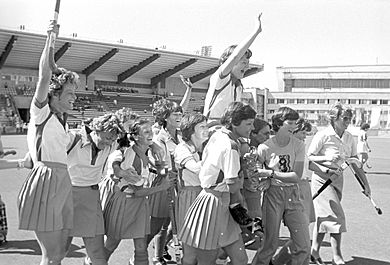
Before 1980, white people almost always represented Rhodesia in international sports. White athletes continued to dominate Zimbabwean participation in some international sports until the 1990s. For example, no Black player was chosen for the Zimbabwean cricket team until 1995.
An exception was association football, where the national team was mostly black. Notable white players included forward Bobby Chalmers and goalkeeper Bruce Grobbelaar.
Many of Zimbabwe's most famous athletes are white. In tennis, the Black family (Cara, Byron, and Wayne) and Kevin Ullyett are well-known doubles players. In the 1990s, Zimbabwe's mostly white cricket team was strong, with players like Andy Flower and Grant Flower. Today, the Zimbabwe national cricket team still has several white players, including Craig Ervine and Sean Williams.
Zimbabwe's most successful recent Olympic athlete is swimmer Kirsty Coventry. She won three medals (including gold) at the 2004 Summer Olympics and four medals (including gold) at the 2008 Summer Olympics. Famous white Zimbabwean golfers include Nick Price, Mark McNulty, and Brendon de Jonge.
Rhodesian-born Charlene Wittstock, who grew up in Bulawayo, became a successful swimmer for South Africa. She is now a well-known public figure due to her marriage to Prince Albert II of Monaco.
Australian rugby player David Pocock is also a famous Zimbabwean. He moved to Australia in 2002 and later became an Australian Senator. He gave up his Zimbabwean citizenship to follow Australian law.
White People in Zimbabwean Politics
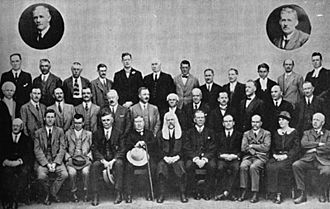
During the UDI era, Rhodesia developed an economy designed to withstand UN sanctions. The country had strict controls on money and imports. This approach continued until around 1990, when international organizations required economic changes for development funding. Zimbabwe adopted the ESAP (Economic Structural Adjustment Programme) in 1991, which involved privatization and removing trade controls.
These economic changes caused some difficulties, including job losses and increased poverty. This led many skilled Zimbabweans, both black and white, to look for work abroad.
Since 1990, Zimbabwean politics has faced economic challenges. However, some parts of the economy, like the stock market and property market, have seen growth.
After independence, some white political leaders, like Ian Smith, wanted white Zimbabweans to remain a separate group. They wanted to keep 20 seats in parliament reserved for white people, but this was abolished in 1987. Despite this, many white Zimbabweans accepted the political changes. Some even joined the ZANU-PF party in the 1980s and 1990s. For example, Timothy Stamps served as Minister of Health from 1986 to 2002.
Wealthy Zimbabweans
In the 2000s, a group of wealthy white businessmen and senior military officers became linked to a part of the ZANU-PF party. This group was associated with Emmerson Mnangagwa, a former Security Minister.
In July 2002, 92 important Zimbabweans faced EU "smart sanctions" because of certain government policies. These people were banned from the EU, and their assets there were frozen. Ninety-one of them were black, and one was white: Dr. Timothy Stamps. Many observers found it strange that Dr. Stamps, who was retired and not involved in wrongdoing, was on the list, while wealthy white supporters of Mugabe were not.
Movement for Democratic Change and 2000 Election
From around 1990 onwards, most white people supported opposition politics against Mugabe's ZANU party. White Zimbabweans wanted liberal economics, democracy, and the rule of law. In 1999, they saw that many people were unhappy with the ZANU government. This gave white people a chance to vote for an opposition party, the Movement for Democratic Change (MDC), which started from trade union movements.
Roy Bennett, a white farmer whose coffee plantation was taken, won a strong victory in the Chimanimani area in the 2000 general election. Bennett won his seat for the MDC and was one of four white MDC Members of Parliament elected in 2000.
Other white MPs elected in 2000 included David Coltart, a human rights lawyer, and Michael Auret, a civil rights activist. Trudy Stevenson was a white American who had lived in Uganda before moving to Zimbabwe. She served as the MDC's Secretary for Policy and Research before being elected to Parliament. In 2006, Stevenson was attacked and injured after a political meeting.
One MDC spokesperson is Eddie Cross, a leading Zimbabwean businessman. He serves as the MDC's Economic Secretary.
The 2000 general election was a very important event in Zimbabwe's post-independence politics. It was the first truly competitive election since 1962, happening during a time of many economic and social problems. The ZANU ruling party had been in power for 20 years. White people played a big role in the MDC's campaign, and the party almost won the election. Some people saw the MDC's efforts as an attempt to bring back a limited form of white minority rule, which led to a strong and sometimes violent reaction.
Recent Events
Since 2000, many white Zimbabweans have felt that laws were not applied fairly when crimes were committed against them.
The independence constitution said that the Zimbabwean government had to pay pensions to former Rhodesian state workers. This included paying foreign currency to pensioners living outside Zimbabwe, most of whom were white. Pension payments were made until the 1990s but became irregular and stopped completely in 2003.
White communities in different African countries had different experiences after colonialism. In some countries like Kenya, Namibia, and Botswana, white communities survived and even grew. Other nations like Zambia invited white African farmers and workers to help develop their economies. However, in Algeria and Zimbabwe, the large European communities shrank. In these cases, the white communities had resisted decolonization, and many found it hard to adjust to losing their higher economic and political status or faced violence from the new governments.
Many observers believe that the failure of some newly independent African countries and their white minorities to get along hurt both sides. Some black Africans felt that white people holding top positions in industries like farming was a reminder of colonialism. However, the departure or forced removal of white Africans sometimes caused the economy and infrastructure to suffer. For example, white farmers and hotel owners from Zimbabwe have helped agriculture and tourism in neighboring Zambia.
The white community was also targeted by Zimbabwean state media, which called them "Britain's Children" and "settlers." This happened even though many second and third-generation white Zimbabweans saw themselves as African.
In 2006, some wealthy white residents of the Borrowdale suburb in Harare were evicted from their homes because they were too close to Mugabe's new house. In 2007, about 100 mostly white youths were arrested during a raid at a nightclub in the area and reportedly attacked by police. In 2008, The Guardian newspaper reported on the growing difficulties faced by the urban white community in Zimbabwe.
In March 2008, Zimbabweans voted in parliamentary and presidential elections. Important white Zimbabwean candidates included David Coltart for the Senate and Trudy Stevenson, Eddie Cross, and Ian Kay for the House of Assembly. All these candidates ran for one of the Movement for Democratic Change groups. Coltart, Cross, and Kay were elected.
The MDC won both the parliamentary and presidential elections. In September 2008, a new "unity" government was formed with MDC leader Morgan Tsvangirai as Prime Minister. Senator Roy Bennett was nominated to be Minister of Lands, Agriculture, and Resettlement, while Cross was nominated to be Minister of International Trade.
In February 2009, The Times reported on the struggles faced by the white community, including the high cost of food and private healthcare. It said that most white residents in Zimbabwe relied on relatives abroad for financial help.
In the same month, the UK Government said it would help elderly British citizens in Zimbabwe move back to the United Kingdom.
In February 2010, new government rules stated that white business owners had to give a 51% share of their business to black Zimbabweans. This proposed law was later dropped.
In March 2010, a group of white farmers who had lost their land were given ownership documents for a valuable property in Cape Town owned by the Zimbabwean government. A South African court had ruled that land seizures in Zimbabwe were illegal. It is expected that other Zimbabwean government assets in South Africa could also be seized as compensation.
The charity Zane ("Zimbabwe, a National Emergency") was started in 2002 to help British passport holders in Zimbabwe who were struggling financially. As of 2010, it continued to support 1,800 white Zimbabweans and also helped the wider Zimbabwean society.
In 2017, new President Emmerson Mnangagwa promised to pay compensation to white farmers whose land was taken. Rob Smart became the first white farmer to get his land back within a month of Mnangagwa becoming president. During the World Economic Forum in 2018, Mnangagwa said that his new government believes thinking about race in farming and land ownership is "outdated" and should be a "philosophy of the past."
|
See also
- British diaspora in Africa
- Greeks in Zimbabwe
- List of white Zimbabweans of European ancestry
- Racism in Zimbabwe
- Zimbabwean diaspora
- History of the Jews in Zimbabwe
- Zimbabweans
- White people
- Italian Zimbabweans


